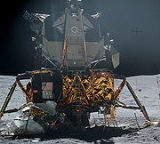
Apollo Lunar Module
Encyclopedia
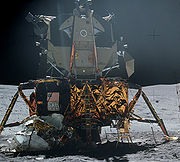 Apollo 16 Young and Duke served as the backup crew for Apollo 13; Mattingly was slated to be the Apollo 13 command module pilot until being pulled from the mission due to his exposure to rubella through Duke.-Backup crew:... LM Orion on the lunar surface |
||
|---|---|---|
| Description | ||
| Role: | manned lunar landing and takeoff | |
| Crew: | 2; CDR, LM Pilot | |
| Dimensions | ||
| Height: | 17.9 ft (5.5 m) | |
| Width: | 14 ft (4.3 m) | |
| Depth: | 13.3 ft (4.1 m) | |
| Landing gear span: | 29.75 ft (9.1 m) | |
| Cockpit volume: | 235 ft3 | |
| Masses | ||
| Ascent stage: | 10024 lb (4,546.8 kg) | |
| Descent stage: | 22375 lb (10,149.1 kg) | |
| Total: | 32399 lb (14,695.9 kg) | |
| Rocket engines | ||
| LM RCS (UDMH/N2O4) x 16: | 100 lbf (444.8 N) | |
| Ascent Propulsion System (Aerozine 50/N2O4): |
3500 lbf (15,568.8 N) | |
| Descent Propulsion System (Aerozine 50/N2O4): |
9982 lbf (44,402.1 N) at full throttle; throttle range of 1050 lbf (4,670.6 N) to 6800 lbf (30,247.9 N) | |
| Performance | ||
| Endurance: | 3 days plus (75 hours) | |
| Apolune: | 100 mi (160.9 km) | |
| Perilune: | surface | |
| Spacecraft delta v: | 15390 ft/s (4,690.9 m/s) | |
| Apollo LM diagram | ||
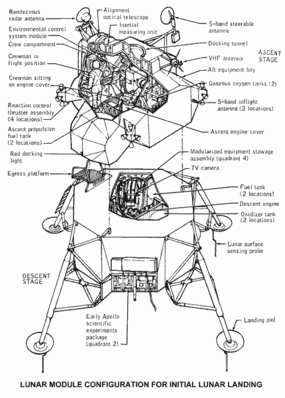 |
||
The Apollo Lunar Module (LM) was the lander
Lander (spacecraft)
A lander is a spacecraft which descends toward and comes to rest on the surface of an astronomical body. For bodies with atmospheres, the landing is called atmospheric reentry and the lander descends as a re-entry vehicle...
portion of the Apollo spacecraft
Apollo spacecraft
The Apollo spacecraft was composed of five combined parts designed to accomplish the American Apollo program's goal of landing astronauts on the Moon by the end of the 1960s and returning them safely to Earth...
built for the US
United States
The United States of America is a federal constitutional republic comprising fifty states and a federal district...
Apollo program by Grumman to carry a crew of two from lunar orbit to the surface and back. Six such craft successfully landed on the Moon between 1969–1972.
The LM, consisting of an Ascent stage and Descent stage, was ferried to lunar orbit by its companion Command/Service Module
Apollo Command/Service Module
The Command/Service Module was one of two spacecraft, along with the Lunar Module, used for the United States Apollo program which landed astronauts on the Moon. It was built for NASA by North American Aviation...
(CSM), a separate spacecraft of approximately twice its mass, which took the astronauts home to Earth. After completing its mission, the LM was discarded. In one sense it was the world's first true spacecraft in that it was capable of operation only in outer space, structurally and aerodynamically incapable of flight through the Earth's atmosphere.
The LM got a later start on its design than the CSM, due to the to the initial unpopularity of the lunar orbit rendezvous
Lunar orbit rendezvous
Lunar orbit rendezvous is a key concept for human landing on the Moon and returning to Earth.In a LOR mission a main spacecraft and a smaller lunar module travel together into lunar orbit. The lunar module then independently descends to the lunar surface. After completion of the mission there, a...
strategy. Its development was also plagued with several hurdles which delayed its first unmanned flight by about ten months, and its first manned flight by about three months. Despite this, the LM eventually became the most reliable component of the Apollo/Saturn system, the only one never to suffer any failure that significantly impacted a mission, and in at least one instance (LM-7 Aquarius
Apollo 13
Apollo 13 was the seventh manned mission in the American Apollo space program and the third intended to land on the Moon. The craft was launched on April 11, 1970, at 13:13 CST. The landing was aborted after an oxygen tank exploded two days later, crippling the service module upon which the Command...
) greatly exceeded its design requirements by maintaining life support for astronauts after an explosion damaged the Apollo Service Module.
Operational profile
At launch, the Lunar Module sat directly beneath the Command/Service ModuleApollo Command/Service Module
The Command/Service Module was one of two spacecraft, along with the Lunar Module, used for the United States Apollo program which landed astronauts on the Moon. It was built for NASA by North American Aviation...
(CSM) with legs folded, inside the Spacecraft-to-LM Adapter (SLA) attached to the S-IVB
S-IVB
The S-IVB was built by the Douglas Aircraft Company and served as the third stage on the Saturn V and second stage on the Saturn IB. It had one J-2 engine...
third stage of the Saturn V rocket. There it remained through earth parking orbit and the Trans Lunar Injection
Trans Lunar Injection
A Trans Lunar Injection is a propulsive maneuver used to set a spacecraft on a trajectory which will arrive at the Moon.Typical lunar transfer trajectories approximate Hohmann transfers, although low energy transfers have also been used in some cases, as with the Hiten probe...
(TLI) rocket burn to send the craft toward the Moon.
Soon after TLI, the SLA opened and the CSM separated, turned around, came back to dock with the Lunar Module, and extracted it from the S-IVB. During the flight to the Moon, the docking hatches were opened and the LM Pilot entered the LM to temporarily power up and test its systems (except for propulsion). Throughout the flight, he performed the role of an engineering officer, responsible for monitoring the systems of both spacecraft.
After achieving a lunar parking orbit, the Commander and LM Pilot entered and powered up the LM, replaced the hatches and docking equipment, unfolded and locked its landing legs, and separated from the CSM, flying independently. The Commander operated the flight controls and engine throttle, while the Lunar Module Pilot operated other spacecraft systems and kept the Commander informed on systems status and navigational information. After inspection of the landing gear by the Command Module Pilot, the LM was withdrawn to a safe distance, then the descent engine was pointed forward into the direction of travel to perform the 30 second Descent Orbit Insertion burn to reduce speed and drop the LM's perilune to within approximately 50000 feet (15.2 km) of the surface, about 260 nautical miles (481.5 km) uprange of the landing site.
At this point, the engine was started again for Powered Descent Initiation. During this time the crew flew on their backs, depending on the computer to slow the craft's forward and vertical velocity to near zero. Control was exercised with a combination of engine throttling and attitude thrusters, guided by the computer with the aid of landing radar. During the braking phase altitude decreased to approximately 10000 feet (3 km), then the final approach phase went to approximately 700 feet (213.4 m). During final approach, the vehicle pitched over to a near-vertical position, allowing the crew to look forward and down to see the lunar surface for the first time.
Finally the landing phase began, approximately 2000 foot (0.6096 km) uprange of the targeted landing site. At this point manual control was enabled for the Commander, and enough fuel reserve was allocated to allow approximately two minutes of hover time to survey where the computer was taking the craft and make any necessary corrections. (If necessary, landing could have been aborted at almost any time by jettisoning the descent stage and firing the ascent engine to climb back into orbit for an emergency return to the CSM.) Finally, three-foot-long probes extending from three footpads of the lander touched the surface, activating the contact indicator light which signaled time for descent engine cutoff, allowing the LM to settle on the surface.
When ready to leave the Moon, the LM would separate the descent stage and fire the ascent engine to climb back into orbit, using the descent stage as a launch platform. After a few course correction burns, the LM would rendezvous with the CSM and dock for transfer of the crew and rock samples. Having completed its job, the LM was separated and sent into solar orbit or to crash into the Moon.
History

Acronym and initialism
Acronyms and initialisms are abbreviations formed from the initial components in a phrase or a word. These components may be individual letters or parts of words . There is no universal agreement on the precise definition of the various terms , nor on written usage...
LEM) was designed after NASA chose to reach the Moon via Lunar Orbit Rendezvous
Lunar orbit rendezvous
Lunar orbit rendezvous is a key concept for human landing on the Moon and returning to Earth.In a LOR mission a main spacecraft and a smaller lunar module travel together into lunar orbit. The lunar module then independently descends to the lunar surface. After completion of the mission there, a...
(LOR) instead of the direct ascent
Direct ascent
Direct ascent was a proposed method for a mission to the Moon. In the United States, direct ascent proposed using the enormous Nova rocket to launch a spacecraft directly to the Moon, where it would land tail-first and then launch off the Moon back to Earth...
or Earth Orbit Rendezvous
Earth orbit rendezvous
Earth orbit rendezvous is a type of space rendezvous and a spaceflight methodology most notable for enabling round trip human missions to the moon...
(EOR) methods. Both direct ascent and EOR would have involved landing a much heavier, complete Apollo spacecraft on the Moon. Once the decision had been made to proceed using LOR, it became necessary to produce a separate craft capable of reaching the lunar surface and ascending back to lunar orbit.
The Lunar Module was built by Grumman Aircraft Engineering and was chiefly designed by the American aerospace engineer, Tom Kelly
Tom Kelly (engineer)
Thomas Joseph Kelly was an American aerospace engineer.Thomas J. Kelly graduated from Cornell University in 1951, where he was a member of the Quill and Dagger society...
. Grumman had begun lunar orbit rendezvous studies in late 1950s and again in 1962. In July 1962, eleven firms were invited to submit proposals for the LEM. Nine did so in September, and Grumman was awarded the contract that same month. The contract cost was expected to be around $350 million. There were initially four major subcontractors—Bell Aerosystems (ascent engine), Hamilton Standard
Hamilton Standard
Hamilton Standard, an aircraft propeller parts supplier, was formed in 1929 when United Aircraft and Transport Corporation consolidated Hamilton Aero Manufacturing and Standard Steel Propeller into the Hamilton Standard Propeller Corporation. Other members of the corporation included Boeing,...
(environmental control systems), Marquardt (reaction control system) and Rocketdyne
Rocketdyne
Rocketdyne was a Rocket engine design and production company headquartered in Canoga Park, California, United States. The company was related to North American Aviation for most of its history. NAA merged with Rockwell International, which was then bought by Boeing in December, 1996...
(descent engine).
The Primary Guidance, Navigation and Control System
Apollo PGNCS
The Apollo Primary Guidance, Navigation and Control System was a self-contained inertial guidance system that allowed Apollo spacecraft to carry out their missions when communications with Earth were interrupted, either as expected, when the spacecraft were behind the moon, or in case of a...
(PGNCS) was developed by the MIT Instrumentation Laboratory
Charles Stark Draper Laboratory
Draper Laboratory is an American not-for-profit research and development organization in Cambridge, Massachusetts. Draper focuses on the design, development, and deployment of advanced technology solutions to problems in national security, space exploration, health care and energy.Originally...
; the Apollo Guidance Computer
Apollo Guidance Computer
The Apollo Guidance Computer provided onboard computation and control for guidance, navigation, and control of the Command Module and Lunar Module spacecraft of the Apollo program...
was manufactured by Raytheon
Raytheon
Raytheon Company is a major American defense contractor and industrial corporation with core manufacturing concentrations in weapons and military and commercial electronics. It was previously involved in corporate and special-mission aircraft until early 2007...
. A backup navigation tool, the Abort Guidance System (AGS), was developed by TRW
TRW
TRW Inc. was an American corporation involved in a variety of businesses, mainly aerospace, automotive, and credit reporting. It was a pioneer in multiple fields including electronic components, integrated circuits, computers, software and systems engineering. TRW built many spacecraft,...
.
Over the course of its development, the name was officially changed to Lunar Module (LM), eliminating the word "excursion". This was because NASA was pushing to get funding for some kind of powered lunar surface mobility and they wanted to make it clear that such "excursions" were beyond the capabilities of the lunar lander itself. (This new excursion capability was eventually realized with the Lunar Rover
Lunar rover
The Lunar Roving Vehicle or lunar rover was a battery-powered four-wheeled rover used on the Moon in the last three missions of the American Apollo program during 1971 and 1972...
.) After the name change from "LEM" to "LM", the pronunciation of the abbreviation did not change, as the habit became ingrained among engineers, the astronauts, and the media to universally pronounce "LM" as "lem" which is easier than saying the letters individually.
Design phase
The first LEM design looked like a smaller version of the Apollo Command/Service ModuleApollo Command/Service Module
The Command/Service Module was one of two spacecraft, along with the Lunar Module, used for the United States Apollo program which landed astronauts on the Moon. It was built for NASA by North American Aviation...
(a cone-shaped cabin atop a cylindrical propulsion section) with folding legs. The second design invoked the idea of a helicopter cockpit with large curved windows and seats, to improve the astronauts' visibility for hover and landing. This also included a second, forward docking port, allowing the LEM crew to take an active role in docking with the CSM.
As the program continued, there were numerous redesigns to save weight (including "Operation Scrape"), improve safety, and fix problems. First to go were the heavy cockpit windows, and the seats; the astronauts would stand while flying the LM, supported by a cable and pulley system, with smaller triangular windows giving them sufficient visibility of the landing site. Later, the redundant forward docking port was removed, which meant the Command Pilot gave up active control of the docking to the Command Module Pilot; he could still see the approaching CSM through a small overhead window. These changes resulted in significant weight savings. Egress while wearing bulky Extra-Vehicular Activity
Extra-vehicular activity
Extra-vehicular activity is work done by an astronaut away from the Earth, and outside of a spacecraft. The term most commonly applies to an EVA made outside a craft orbiting Earth , but also applies to an EVA made on the surface of the Moon...
(EVA) spacesuits was also facilitated by a simpler-opening forward hatch.
A configuration freeze did not start until April 1963, when the ascent and descent engine designs were decided. In addition to Rocketdyne, a parallel program for the descent engine was ordered from Space Technology Laboratories (TRW) in July 1963, and by January 1965 the Rocketdyne contract was canceled.
Power was initially to be produced by fuel cell
Fuel cell
A fuel cell is a device that converts the chemical energy from a fuel into electricity through a chemical reaction with oxygen or another oxidizing agent. Hydrogen is the most common fuel, but hydrocarbons such as natural gas and alcohols like methanol are sometimes used...
s built by Pratt and Whitney similar to the CSM, but in March 1965 these were discarded in favor of an all-battery design.
The initial design had three landing legs. As any particular leg would have to carry the weight of the vehicle if it lands at any significant angle, three legs was the lightest configuration. However, it would be the least stable if one of the legs were damaged during landing. The next landing gear design iteration had five legs and was the most stable configuration for landing on an unknown terrain. That configuration, however, was too heavy and the designers compromised on four landing legs.
Astronaut training
To allow astronauts to learn lunar landing techniques, NASA contracted Bell Aerosystems in 1964 to build the Lunar Landing Research VehicleLunar Landing Research Vehicle
The Bell Aerosystems Lunar Landing Research Vehicle was an Apollo Project era program to build a simulator for the Moon landings. The LLRVs, humorously referred to as "flying bedsteads", were used by the FRC, now known as the NASA Dryden Flight Research Center, at Edwards Air Force Base,...
(LLRV), which used a gimbal-mounted vertical jet engine to counter 5/6 of its weight to simulate the Moon's gravity, in addition to its own hydrogen peroxide thrusters to simulate the LM's descent engine and attitude control. Successful testing of two LLRV prototypes at the Dryden Flight Research Center
Dryden Flight Research Center
The Dryden Flight Research Center , located inside Edwards Air Force Base, is an aeronautical research center operated by NASA. On March 26, 1976 it was named in honor of the late Hugh L. Dryden, a prominent aeronautical engineer who at the time of his death in 1965 was NASA's deputy administrator...
led in 1966 to three production Lunar Landing Training Vehicles (LLTV) which along with the LLRV's were used to train the astronauts at the Houston Manned Spacecraft Center. This aircraft actually proved fairly dangerous to fly, as three of the five were destroyed in crashes. It was equipped with a rocket-powered ejection seat, so in each case the pilot survived, including the first man to walk on the Moon, Neil Armstrong
Neil Armstrong
Neil Alden Armstrong is an American former astronaut, test pilot, aerospace engineer, university professor, United States Naval Aviator, and the first person to set foot upon the Moon....
.
Development flights
The first unmanned LM flight was planned for April 1967, but because of development delays did not occur until January 22, 1968 when the Apollo 5Apollo 5
Apollo 5 was the first unmanned flight of the Apollo Lunar Module, which would later carry astronauts to the lunar surface. It lifted off on January 22, 1968 with a Saturn IB rocket.-Objectives:...
flight launched the LM-1 atop a Saturn IB
Saturn IB
The Saturn IB was an American launch vehicle commissioned by the National Aeronautics and Space Administration for use in the Apollo program...
for propulsion systems testing in low Earth orbit. A second unmanned test flight of LM-2 was originally planned, but canceled as unnecessary.
The first manned LM flight was also delayed, planned for Apollo 8 in December 1968 but not occurring until Apollo 9
Apollo 9
Apollo 9, the third manned mission in the American Apollo space program, was the first flight of the Command/Service Module with the Lunar Module...
using LM-3 on March 3, 1969 to test the LM's systems, separation and docking in low Earth orbit. Apollo 9 had been planned as a second manned, higher Earth orbit practice flight, but this was cancelled to keep the program timeline on track.
Apollo 10
Apollo 10
Apollo 10 was the fourth manned mission in the American Apollo space program. It was an F type mission—its purpose was to be a "dry run" for the Apollo 11 mission, testing all of the procedures and components of a Moon landing without actually landing on the Moon itself. The mission included the...
, launched on May 18, 1969, was a "dress rehearsal" for the lunar landing, practicing all phases of the mission except powered descent initiation through takeoff. The LM descended to 47400 feet (14.4 km) above the lunar surface, then jettisoned the descent stage and used its ascent engine to return to the CSM.
Production flights
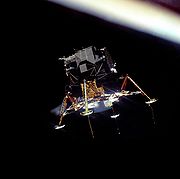
Apollo 11
In early 1969, Bill Anders accepted a job with the National Space Council effective in August 1969 and announced his retirement as an astronaut. At that point Ken Mattingly was moved from the support crew into parallel training with Anders as backup Command Module Pilot in case Apollo 11 was...
LM Eagle, achieving President John F. Kennedy's goal of "landing a man on the Moon and returning him safely to the Earth." Eagle safely returned its crew members to the Command Module, which safely splashed down four days later.
This was followed by precision landings on Apollo 12
Apollo 12
Apollo 12 was the sixth manned flight in the American Apollo program and the second to land on the Moon . It was launched on November 14, 1969 from the Kennedy Space Center, Florida, four months after Apollo 11. Mission commander Charles "Pete" Conrad and Lunar Module Pilot Alan L...
(Intrepid) and Apollo 14
Apollo 14
Apollo 14 was the eighth manned mission in the American Apollo program, and the third to land on the Moon. It was the last of the "H missions", targeted landings with two-day stays on the Moon with two lunar EVAs, or moonwalks....
(Antares) with the aid of upgraded computers and navigational techniques.
In April 1970, the Apollo 13
Apollo 13
Apollo 13 was the seventh manned mission in the American Apollo space program and the third intended to land on the Moon. The craft was launched on April 11, 1970, at 13:13 CST. The landing was aborted after an oxygen tank exploded two days later, crippling the service module upon which the Command...
Lunar Module Aquarius played an unexpected role in saving the lives of the three astronauts after an oxygen tank in the Service Module ruptured, disabling the CSM. Aquarius served as a "lifeboat" for the astronauts during their return to Earth. Its descent stage engine was used to replace the crippled CSM Service Propulsion System engine, and its batteries supplied power for the trip home and recharged the Command Module's batteries critical for re-entry. The astronauts splashed down safely on April 17, 1970. The LM's systems, designed to support two astronauts for 45 hours, actually stretched to support three astronauts for 90 hours.
Extended J Class Missions
The Extended Lunar Modules (ELM) used on the final three "J-class missions", Apollo 15Apollo 15
Apollo 15 was the ninth manned mission in the American Apollo space program, the fourth to land on the Moon and the eighth successful manned mission. It was the first of what were termed "J missions", long duration stays on the Moon with a greater focus on science than had been possible on previous...
, 16
Apollo 16
Young and Duke served as the backup crew for Apollo 13; Mattingly was slated to be the Apollo 13 command module pilot until being pulled from the mission due to his exposure to rubella through Duke.-Backup crew:...
and 17
Apollo 17
Apollo 17 was the eleventh and final manned mission in the American Apollo space program. Launched at 12:33 a.m. EST on December 7, 1972, with a three-member crew consisting of Commander Eugene Cernan, Command Module Pilot Ronald Evans, and Lunar Module Pilot Harrison Schmitt, Apollo 17 remains the...
, were significantly upgraded to allow for greater landing payload weights and longer lunar surface stay times. The descent engine power was improved by the addition of a 10 inches (254 mm) extension to the engine bell, and the descent fuel tanks were increased in size. A waste storage tank was added to the descent stage, with plumbing from the ascent stage. These upgrades allowed stay times of up to 75 hours on the Moon.
The Lunar Roving Vehicle was carried, stowed on Quadrant 1 of the ELM descent stage and deployed by astronauts after landing. This allowed them to explore large areas and return a greater variety of lunar samples.
Hover times and landing weights were also maximized by using the Service Module engine to perform the initial Descent Orbit Insertion burn before the LM separated from the CSM, a practice begun on Apollo 14. The LM then began its powered descent with a full load of descent stage fuel. This method allowed the final three Apollo landings to be made with enough reserve fuel for over a minute of hover time.
Specifications
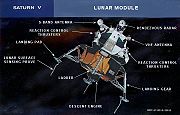
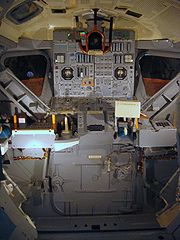
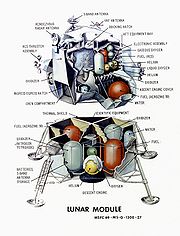
Ascent stage
The Ascent stage contained the crew cabin; environmental control (life support) system; instrument panels; overhead hatch/docking port; forward EVA hatch; sixteen Reaction Control System (RCS) thrusters (identical to those used on the Service Module) mounted in four quads; rendezvous radar; VHF and S-band communications equipment and antennas; guidance and navigation systems (primary and backup); active thermal control system (an ice sublimator); Ascent Propulsion System (APS) engine; and enough fuel, battery power, cooling water, and breathing oxygen to return to lunar orbit and rendezvous with the Apollo Command/Service ModuleApollo Command/Service Module
The Command/Service Module was one of two spacecraft, along with the Lunar Module, used for the United States Apollo program which landed astronauts on the Moon. It was built for NASA by North American Aviation...
. The ascent stage also carried lunar rock and soil samples back with the crew, as much as 238 pounds (108 kg) on Apollo 17.
- Crew: 2
- Crew cabin volume: 235 ft3
- Height: 9.29 ft (2.8 m)
- Width: 14.08 ft (4.3 m)
- Depth: 13.25 ft (4 m)
- Mass including fuel: 10300 lb (4,672 kg)
- Atmosphere: 100% oxygen at 4.8 psi (33.1 kPa)
- Water: two 42.5 lb (19.3 kg) storage tanks
- Coolant: 25 pounds (11.3 kg) of ethylene glycolEthylene glycolEthylene glycol is an organic compound widely used as an automotive antifreeze and a precursor to polymers. In its pure form, it is an odorless, colorless, syrupy, sweet-tasting liquid...
/ water solution - Thermal Control: one active water-ice sublimator
- RCS propellant mass: 633 lb (287.1 kg)
- RCS thrusters: sixteen x 100 lbf (444.8 N) in four quads
- RCS propellants: Aerozine 50Aerozine 50Aerozine 50 is a 50/50 mix of hydrazine and unsymmetrical dimethylhydrazine . Originally developed in the late 1950s by Aerojet General Corporation as a storable, high-energy, hypergolic fuel for the Titan II ICBM rocket engines, Aerozine continues in wide use as a rocket fuel, typically with...
fuel / nitrogen tetroxideDinitrogen tetroxideDinitrogen tetroxide is the chemical compound N2O4. It is a useful reagent in chemical synthesis. It forms an equilibrium mixture with nitrogen dioxide; some call this mixture dinitrogen tetroxide, while some call it nitrogen dioxide.Dinitrogen tetroxide is a powerful oxidizer, making it highly...
(N2O4) oxidizer - RCS specific impulseSpecific impulseSpecific impulse is a way to describe the efficiency of rocket and jet engines. It represents the derivative of the impulse with respect to amount of propellant used, i.e., the thrust divided by the amount of propellant used per unit time. If the "amount" of propellant is given in terms of mass ,...
: 290 s (2,840 N·s/kg) - APS propellant mass: 5187 lb (2,352.8 kg)
- APS engine: RocketdynePratt & Whitney RocketdynePratt & Whitney Rocketdyne is a United States company that designs and produces rocket engines that use liquid propellants. Pratt & Whitney Rocketdyne, headquartered in Canoga Park, California, is a division of Pratt & Whitney, itself a wholly owned subsidiary of United Technologies Corporation...
RS-18 - APS thrust: 3500 lbf (15,568.8 N)
- APS propellants: Aerozine 50 fuel / nitrogen tetroxide oxidizer
- APS pressurant: two 6.4 lb (2.9 kg) helium tanks at 3000 pound per square inches (20.7 MPa)
- APS specific impulseSpecific impulseSpecific impulse is a way to describe the efficiency of rocket and jet engines. It represents the derivative of the impulse with respect to amount of propellant used, i.e., the thrust divided by the amount of propellant used per unit time. If the "amount" of propellant is given in terms of mass ,...
: 311 s (3,050 N·s/kg) - APS delta-VDelta-vIn astrodynamics a Δv or delta-v is a scalar which takes units of speed. It is a measure of the amount of "effort" that is needed to change from one trajectory to another by making an orbital maneuver....
: 7280 ft/s (2,218.9 m/s) - Thrust-to-weight ratioThrust-to-weight ratioThrust-to-weight ratio is a ratio of thrust to weight of a rocket, jet engine, propeller engine, or a vehicle propelled by such an engine. It is a dimensionless quantity and is an indicator of the performance of the engine or vehicle....
at liftoff: 2.124 (in lunar gravity) - Batteries: two 28–32 volt, 296 ampere-hourAmpere-hourAn ampere-hour or amp-hour is a unit of electric charge, with sub-units milliampere-hour and milliampere second...
silver-zinc batteriesSilver-oxide batteryA silver oxide battery , not to be confused with a similar but different silver–zinc battery, which is a secondary cell, is a primary cell with relatively very high energy/weight ratio. They are costly due to the high price of silver...
; 125 lb (56.7 kg) each - Power: 28 V DC, 115 V 400 Hz AC
Descent stage
The Descent stage contained the landing gear; EVA ladder; landing radar; Descent Propulsion System (DPS) engine and fuel to land on the Moon. It had several cargo compartments with replacement Portable Life Support SystemPrimary Life Support System
A Primary Life Support System , is a device connected to an astronaut's or cosmonaut's spacesuit, which allows extra-vehicular activity with maximum freedom, independent of a spacecraft's life support system. The PLSS is generally worn like a backpack...
(PLSS) batteries and lithium hydroxide canisters; the Apollo Lunar Surface Experiment Package ALSEP; Mobile Equipment Cart (a hand-pulled equipment cart used on Apollo 14
Apollo 14
Apollo 14 was the eighth manned mission in the American Apollo program, and the third to land on the Moon. It was the last of the "H missions", targeted landings with two-day stays on the Moon with two lunar EVAs, or moonwalks....
) or the Lunar Rover
Lunar rover
The Lunar Roving Vehicle or lunar rover was a battery-powered four-wheeled rover used on the Moon in the last three missions of the American Apollo program during 1971 and 1972...
(used on Apollo 15-17); deployable S-band antenna (Apollo 11-14); surface television camera; surface tools; and lunar sample collection boxes. The descent stage carried consumables for the lunar stay: batteries; oxygen and water for drinking and cooling. The No. 1 landing gear leg carried a stainless steel plaque near the ladder commemorating each landing flight, listing the names of the astronauts, and in the case of the first and last, the President of the United States (Richard M. Nixon
Richard Nixon
Richard Milhous Nixon was the 37th President of the United States, serving from 1969 to 1974. The only president to resign the office, Nixon had previously served as a US representative and senator from California and as the 36th Vice President of the United States from 1953 to 1961 under...
).
- Height minus landing probes: 8.59 ft (2.6 m)
- Width/depth minus landing gear: 12.83 ft (3.9 m)
- Width/depth including landing gear: 31 ft (9.4 m)
- Mass including fuel: 22783 lb (10,334.2 kg)
- Water: one 151 kg (332.9 lb) storage tank
- DPS propellant mass: 18000 lb (8,164.7 kg)
- DPS thrust: 10125 lbf (45,038.2 N), throttleable between 10% and 60% of full thrust
- DPS propellants: Aerozine 50 / nitrogen tetroxide
- DPS pressurant: one 49 pounds (22.2 kg) supercritical helium tank at 1555 psi (10.7 MPa)
- DPS specific impulseSpecific impulseSpecific impulse is a way to describe the efficiency of rocket and jet engines. It represents the derivative of the impulse with respect to amount of propellant used, i.e., the thrust divided by the amount of propellant used per unit time. If the "amount" of propellant is given in terms of mass ,...
: 311 s (3,050 N·s/kg) - DPS delta-VDelta-vIn astrodynamics a Δv or delta-v is a scalar which takes units of speed. It is a measure of the amount of "effort" that is needed to change from one trajectory to another by making an orbital maneuver....
: 8100 ft/s (2,468.9 m/s) - Batteries: four (Apollo 9-14) or five (Apollo 15-17) 28–32 V, 415 A·h silver-zinc batteries; 135 lb (61.2 kg) each
Lunar Modules produced
| Serial number | Name | Use | Launch date | Current location | Image |
|---|---|---|---|---|---|
| LM-1 | Apollo 5 Apollo 5 Apollo 5 was the first unmanned flight of the Apollo Lunar Module, which would later carry astronauts to the lunar surface. It lifted off on January 22, 1968 with a Saturn IB rocket.-Objectives:... |
January 22, 1968 | Reentered Earth's atmosphere |  |
|
| LM-2 | Intended for second unmanned flight; not used |
On display at the National Air and Space Museum National Air and Space Museum The National Air and Space Museum of the Smithsonian Institution holds the largest collection of historic aircraft and spacecraft in the world. It was established in 1976. Located in Washington, D.C., United States, it is a center for research into the history and science of aviation and... , Washington, DC |
 |
||
| LM-3 | Spider | Apollo 9 Apollo 9 Apollo 9, the third manned mission in the American Apollo space program, was the first flight of the Command/Service Module with the Lunar Module... |
March 3, 1969 | Reentered Earth's atmosphere | 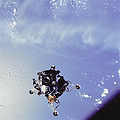 |
| LM-4 | Snoopy | Apollo 10 Apollo 10 Apollo 10 was the fourth manned mission in the American Apollo space program. It was an F type mission—its purpose was to be a "dry run" for the Apollo 11 mission, testing all of the procedures and components of a Moon landing without actually landing on the Moon itself. The mission included the... |
May 18, 1969 | Descent stage impacted Moon; Ascent stage in solar orbit. Snoopy is the only surviving flown LM ascent stage. | |
| LM-5 | Eagle | Apollo 11 Apollo 11 In early 1969, Bill Anders accepted a job with the National Space Council effective in August 1969 and announced his retirement as an astronaut. At that point Ken Mattingly was moved from the support crew into parallel training with Anders as backup Command Module Pilot in case Apollo 11 was... |
July 16, 1969 | Descent stage on lunar surface; Ascent stage left in lunar orbit (orbit decayed: impact location on moon unknown) | 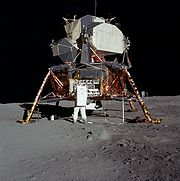 |
| LM-6 | Intrepid | Apollo 12 Apollo 12 Apollo 12 was the sixth manned flight in the American Apollo program and the second to land on the Moon . It was launched on November 14, 1969 from the Kennedy Space Center, Florida, four months after Apollo 11. Mission commander Charles "Pete" Conrad and Lunar Module Pilot Alan L... |
November 14, 1969 | Descent stage on lunar surface; Ascent stage deliberately crashed into Moon | 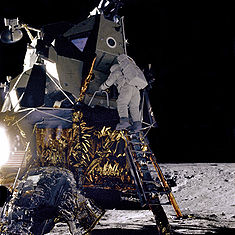 |
| LM-7 | Aquarius | Apollo 13 Apollo 13 Apollo 13 was the seventh manned mission in the American Apollo space program and the third intended to land on the Moon. The craft was launched on April 11, 1970, at 13:13 CST. The landing was aborted after an oxygen tank exploded two days later, crippling the service module upon which the Command... |
April 11, 1970 | Reentered Earth's atmosphere |  |
| LM-8 | Antares | Apollo 14 Apollo 14 Apollo 14 was the eighth manned mission in the American Apollo program, and the third to land on the Moon. It was the last of the "H missions", targeted landings with two-day stays on the Moon with two lunar EVAs, or moonwalks.... |
January 31, 1971 | Descent stage on lunar surface; Ascent stage deliberately crashed into Moon | |
| LM-9 | Not flown (originally intended as Apollo 15, last H-class mission) |
On display at the Kennedy Space Center Kennedy Space Center The John F. Kennedy Space Center is the NASA installation that has been the launch site for every United States human space flight since 1968. Although such flights are currently on hiatus, KSC continues to manage and operate unmanned rocket launch facilities for America's civilian space program... (Apollo/Saturn V Center) |
 |
||
| LM-10 | Falcon | Apollo 15 Apollo 15 Apollo 15 was the ninth manned mission in the American Apollo space program, the fourth to land on the Moon and the eighth successful manned mission. It was the first of what were termed "J missions", long duration stays on the Moon with a greater focus on science than had been possible on previous... , first ELM |
July 26, 1971 | Descent stage on lunar surface; Ascent stage deliberately crashed into Moon |  |
| LM-11 | Orion | Apollo 16 Apollo 16 Young and Duke served as the backup crew for Apollo 13; Mattingly was slated to be the Apollo 13 command module pilot until being pulled from the mission due to his exposure to rubella through Duke.-Backup crew:... |
April 16, 1972 | Descent stage on lunar surface; Ascent stage left in lunar orbit, eventually crashed on Moon |  |
| LM-12 | Challenger | Apollo 17 Apollo 17 Apollo 17 was the eleventh and final manned mission in the American Apollo space program. Launched at 12:33 a.m. EST on December 7, 1972, with a three-member crew consisting of Commander Eugene Cernan, Command Module Pilot Ronald Evans, and Lunar Module Pilot Harrison Schmitt, Apollo 17 remains the... |
December 7, 1972 | Descent stage on lunar surface; Ascent stage deliberately crashed into Moon |  |
| LM-13 |
Not flown (originally intended as Apollo 19) |
Partially completed by Grumman Grumman Aircraft Engineering Corporation The Grumman Aircraft Engineering Corporation, later Grumman Aerospace Corporation, was a leading 20th century U.S. producer of military and civilian aircraft... ; restored and on display at Cradle of Aviation Museum Cradle of Aviation Museum The Cradle of Aviation Museum is an aerospace museum located in East Garden City, New York on Long Island to commemorate Long Island's part in the history of aviation. It is located on land once part of Mitchel Air Force Base which, together with nearby Roosevelt Field and other airfields on the... , Long Island, New York. Also used during HBO's 1998 mini-series From the Earth to the Moon. |
|||
| LM-14 |
Not flown (originally intended as Apollo 20) |
Never completed; unconfirmed reports claim that some parts (in addition to parts from test vehicle LTA-3) are included in LM on display at the Franklin Institute Franklin Institute The Franklin Institute is a museum in Philadelphia, Pennsylvania, and one of the oldest centers of science education and development in the United States, dating to 1824. The Institute also houses the Benjamin Franklin National Memorial.-History:On February 5, 1824, Samuel Vaughn Merrick and... , Philadelphia (see Franklin Institute web page.) |
|||
| LM-15 |
Not flown (might have been Apollo Telescope Mount Apollo Telescope Mount The Apollo Telescope Mount, or ATM, is the name of a solar observatory that was attached to Skylab, the first US space station.The ATM was one of a number of projects that came out of the late 1960s Apollo Applications Program, which studied a wide variety of ways to use the infrastructure... ) |
Scrapped |
|||
| * For the location of LMs left on the Lunar surface, see the list of man-made objects on the Moon. | |||||
Apollo Telescope Mount
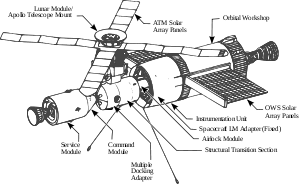
Apollo Command/Service Module
The Command/Service Module was one of two spacecraft, along with the Lunar Module, used for the United States Apollo program which landed astronauts on the Moon. It was built for NASA by North American Aviation...
, named the Apollo Telescope Mission (ATM).
This idea was later transferred to the original wet workshop
Wet workshop
Wet workshop is the idea of using a spent rocket stage as a makeshift space station. A liquid-fuel rocket primarily consists of two large, airtight fuel tanks; it was realized that the fuel tanks could be retrofitted into the living quarters of a space station. A large rocket stage would reach a...
design for the Skylab
Skylab
Skylab was a space station launched and operated by NASA, the space agency of the United States. Skylab orbited the Earth from 1973 to 1979, and included a workshop, a solar observatory, and other systems. It was launched unmanned by a modified Saturn V rocket, with a mass of...
orbital workshop and renamed the Apollo Telescope Mount
Apollo Telescope Mount
The Apollo Telescope Mount, or ATM, is the name of a solar observatory that was attached to Skylab, the first US space station.The ATM was one of a number of projects that came out of the late 1960s Apollo Applications Program, which studied a wide variety of ways to use the infrastructure...
to be docked on a side port of the workshop's Multiple Docking Adapter (MDA). When Skylab changed to a "dry workshop" design pre-fabricated on the ground and launched on a Saturn V, the telescope was mounted on a hinged arm and controlled from inside the MDA. Only the octagonal shape of the telescope container, solar panels and the Apollo Telescope Mount name were kept, though there was no longer any association with the LM.
LM truck (aka Lunar Payload Module)
The Apollo LM Truck was a stand-alone LM descent stage intended to deliver up to 11000 pounds (5 t) of payload to the Moon for an unmanned landing. This technique was intended to deliver equipment and supplies to a permanent manned lunar base. As originally proposed, it would be launched on a Saturn V with a full Apollo crew to accompany it to lunar orbit and guide it to a landing next to the base; then the base crew would unload the "truck" while the orbiting crew returned to Earth. In later AAP plans, the LPM would have been delivered by an unmanned lunar ferry vehicle.Depiction in fiction
The development and construction of the lunar module is dramatized in the miniseries From the Earth to the Moon episode entitled "Spider". This is in reference to LM-3, used on Apollo 9, which the crew named Spider after its spidery appearance.The Ron Howard film Apollo 13
Apollo 13 (film)
Apollo 13 is a 1995 American drama film directed by Ron Howard. The film stars Tom Hanks, Kevin Bacon, Bill Paxton, Gary Sinise, Kathleen Quinlan and Ed Harris. The screenplay by William Broyles, Jr...
, a dramatization of that mission starring Tom Hanks
Tom Hanks
Thomas Jeffrey "Tom" Hanks is an American actor, producer, writer, and director. Hanks worked in television and family-friendly comedies, gaining wide notice in 1988's Big, before achieving success as a dramatic actor in several notable roles, including Andrew Beckett in Philadelphia, the title...
and Kevin Bacon
Kevin Bacon
Kevin Norwood Bacon is an American film and theater actor whose notable roles include Animal House, Diner, Footloose, Flatliners, Wild Things, A Few Good Men, JFK, Apollo 13, Mystic River, The Woodsman, Trapped, Friday the 13th, Hollow Man, Tremors, Death Sentence, Frost/Nixon, Crazy, Stupid, Love....
, was filmed using realistic spacecraft interior reconstructions of the Aquarius and the Command Module Odyssey. Actors portrayed the crew, floating realistically during most of the mission in scenes filmed in NASA's zero-g training aircraft.
See also
- Apollo Command/Service ModuleApollo Command/Service ModuleThe Command/Service Module was one of two spacecraft, along with the Lunar Module, used for the United States Apollo program which landed astronauts on the Moon. It was built for NASA by North American Aviation...
- List of artificial objects on the Moon
- Lunar Roving Vehicle
- Project ApolloProject ApolloThe Apollo program was the spaceflight effort carried out by the United States' National Aeronautics and Space Administration , that landed the first humans on Earth's Moon. Conceived during the Presidency of Dwight D. Eisenhower, Apollo began in earnest after President John F...
- Lunar Escape SystemsLunar Escape SystemsLunar Escape Systems were a series of emergency vehicles designed for never-flown long-duration Apollo missions. Because these missions were even more hypothetical than the planned cancelled Apollo missions, the designs were never constructed.-Details:...
External links
- Google Moon overview of Apollo landing sites
- NASA catalog: Apollo 14 Lunar Module
- Space/Craft Assembly & Test Remembered – A site "dedicated to the men and women that designed, built and tested the Lunar Module at Grumman Aerospace Corporation, Bethpage, New York"
- We Called It 'The Bug', By D.C. Agle, Air & Space Magazine, September 1, 2001 - Excellent overview of LM descent
- Apollo 11 LM Structures handout for LM-5 (PDF) – Training document given to astronauts which illustrates all discrete LM structures
- Apollo Operations Handbook, Lunar Module (LM 10 and Subsequent), Volume One. Subsystems Data (PDF) Manufacturers Handbook covering the systems of the LM.
- Apollo Operations Handbook, Lunar Module (LM 11 and Subsequent), Volume Two. Operational Procedures Manufacturers Handbook covering the procedures used to fly the LM.
- Apollo 15 LM Activation Checklist for LM-10 – Checklist detailing how to prepare the LM for activation and flight during a mission
- Lunar Module Launch Video
- Lander On-line 2D Lunar Module Landing Simulation Game
- Easy Lander 3D Lunar Module Landing Simulation Game

